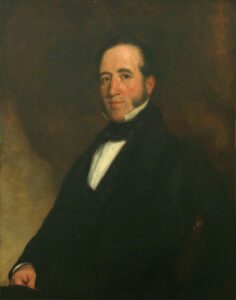
Dr Charlotte MacKenzie, regular Cornish Story contributor, is a prolific writer and speaker on Cornish History and here she turns her attention to the Opie family.
Occasionally, paintings believed to be lost are rediscovered. Or a known painting is identified as by a particular artist. The current whereabouts of paintings by the exceptionally talented Cornish artist, John Opie (1761-1807), are not all known. Though some of these may be in private ownership. The portrait of Edward John Spry, MRCS, who was Mayor of Truro on three occasions, was recently identified as by John Opie’s great nephew Edward Opie (1810-1894).
In between these two there was a third Cornish artist named Opie, who was and is much less well known. Richard Opie (d.1864) married Agnes Andrew at Stoke Damerel in 1813, where the parish register described his age as ‘minor’. Their two eldest sons were Richard Opie (1815-87) and Edward Andrew Opie (1818-79). The first quarter century of
their marriage was living in Cornwall, initially in Stithians and then in Falmouth where most of their family was listed in the 1841 census.
Richard Opie travelled in Cornwall to complete portraits and creatively promote his talents. Before photography was developed, there were many families who liked to have miniatures or larger portraits painted, not least before a loved one left to travel overseas. And there were artists who painted these, at a price which was in reach of some families.
In October 1832, the Royal Cornwall Gazette was forced to apologise after reporting that a portrait by John Opie’s great nephew Edward had been recognised and licked by the subject’s dog; the portrait on display in a St Austell shop had in fact been completed by ‘Mr Opie of Stithians’.
In February 1838, the Sun newspaper in London reported that Richard Opie’s portrait of the former Dolcoath mine Captain Joseph Odgers, a French prisoner turned preacher, was now at the Commercial Hotel in Camborne. Where people could see for themselves that, in ‘The halter pie’, Opie had produced ‘such a striking likeness of Captain Joe’ who was known for using vernacular language when preaching.
By then Richard Opie and two of his sons may all have been earning their livings as artists and craftsmen. The eldest son, also named Richard Opie, initially painted portraits and then pursued a career as a carver and gilder who made picture frames.
On 13 October 1837, the Royal Cornwall Gazette report of the Royal Cornwall Polytechnic Society fifth annual exhibition listed as prize winners ‘For oil paintings by professional artists ‘Altar Piece, Andrew Opie, Falmouth’. For crayon pictures by professional artists ‘Last Fight at Bosworth, A. Opie, Falmouth’. Richard and Agnes Opie’s second son, Edward Andrew Opie, may have identified himself as Andrew Opie to avoid confusion with the better-established portrait painter Edward Opie. The prize oil painting may have been the work later identified in February 1838 as ‘The Halter pie’ by Richard Opie, which was on display in the Commercial Hotel, Camborne. By March 1839 Edward Andrew Opie was in Melbourne, Australia.
In the 1840s, Richard Opie’s family relocated to Plymouth. Fleeting references aside, unfortunately no pictures have been identified as painted by Richard Opie. Nonetheless, he consistently identified himself as a portrait painter or artist, and while so doing prospered sufficiently to raise eight children including the two sons who were also creatives.
In Australia, Edward Opie found work partly in theatres, acting and painting scenery. He placed advertisements offering to teach drawing, and paint portraits. He moved between towns, including to Geelong in the 1850s, where he may have followed the gold rush. He had one son. He is remembered today as an Australian artist, whose known works are listed here daao.org.au/bio/edward-opie/works/ .
This branch of the Opie family clearly had artistic talents, and like many Cornish families at the time relocated within the UK or overseas to create a future for their families.
Charlotte MacKenzie is the author of nine Cornish history books. She has jointly written, edited, or contributed to other history books. Research for her latest books on Cornish medics (2024), Cornish mysteries (2023), and Cornish legends (2022) was partly supported by a Q Fund grant in November 2022. Charlotte won the 2016 Cardew Rendle prize awarded by the Royal Cornwall Museum, published an article in the National Maritime Museum Cornwall online journal Troze in December 2016, and is a contributor to the Journal of the Royal Institution of Cornwall, and Cornish Studies. She was previously a senior lecturer in history at Bath Spa University.
